Proposed National Park Reserve in Pituamkek (Hog Island and the Sandhills) — Public engagement survey and consultations summary
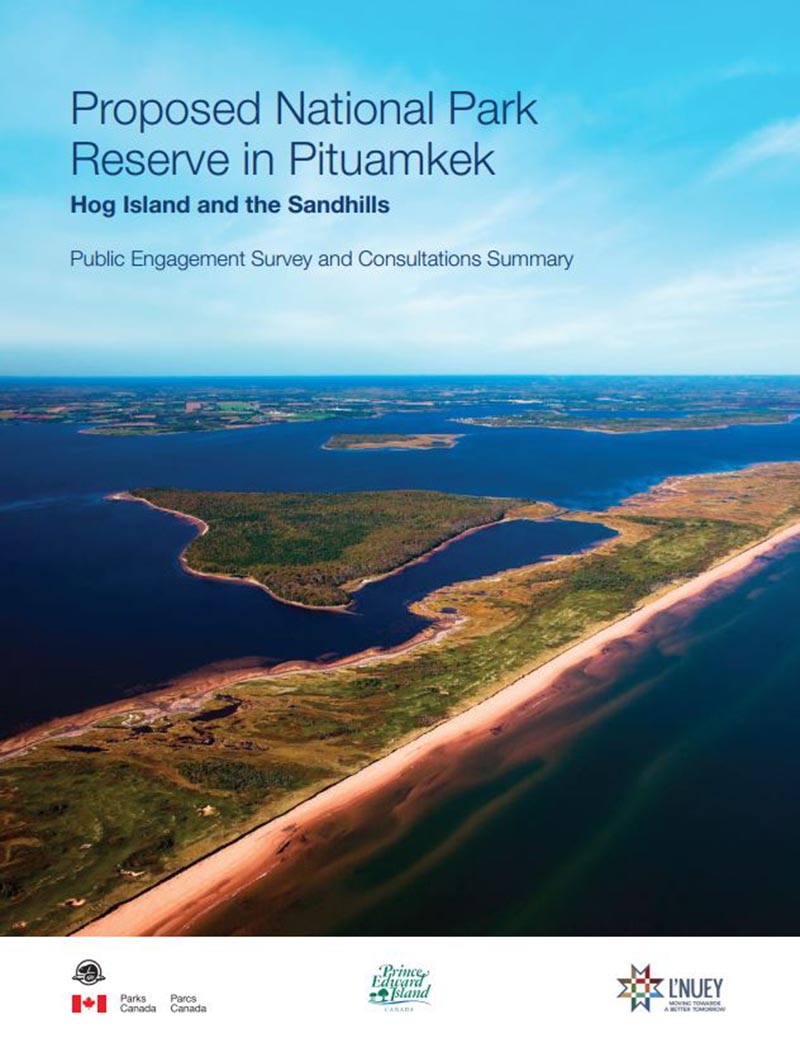
Table of contents
- Executive summary
- Survey responses - Demographics summary
- Survey responses - Themes summary
- Theme: Benefits
- Theme: Concerns
- Theme: Activities
- Level of importance for each factor
- What makes Pituamkek special
- Additional suggestions, ideas, comments, or questions
- Pituamkek public engagement sessions summary
- Conclusions
Executive summary
Background
Pituamkek (Hog Island and the Sandhills) is located in northwestern Prince Edward Island (Epekwitk), the area known by many people in English as Hog Island and the Sandhills. Known as Pituamkek (Bee-doo-um-gek) in the Mi’kmaq language, Pituamkek means ‘At the Long Sand Dune.’ It is rich in ancient Mi’kmaq history, and is home to an ongoing tradition of Mi’kmaq land and resource use. In August 2019, the Government of Canada, the Government of Prince Edward Island, and the Mi’kmaq Governments of Lennox Island and Abegweit First Nations announced the launch of a feasibility assessment on the establishment of a national park reserve in Pituamkek. As part of the feasibility assessment, the public was invited to provide input into the project through an online survey and a series of public consultation sessions coordinated by Parks Canada.
A new national park reserve presents an opportunity for the governments of Canada and the PEI First Nations to strengthen their relationship, and will contribute to Canada’s growing network of protected and conserved areas. These protected areas help safeguard Canada’s biodiversity, the Island’s unique coastal wilderness, and provide unprecedented opportunities for Canadians to experience the outdoors, learn about our environment, and significantly contribute to the protection and preservation of Canada’s most vulnerable ecosystems.
Data collection
Parks Canada was responsible for developing, coordinating, and facilitating the data collection for this feasibility study. The survey was designed and built internally by Parks Canada’s Social Sciences department. Parks Canada completed consultations over a 6-week period which included public surveys, engagement sessions, and stakeholder meetings to gather insight and feedback on the perceptions, concerns, and interest in the Pituamkek park project.
It should be noted that the survey and all public consultations organized for this feasibility study were conducted during the COVID-19 global pandemic. Measures were taken to offer public consultation sessions using an online meeting platform (Zoom) when in-person meetings were not accessible. The survey was promoted on the Parks Canada website, in local newspapers, on local radio stations, and on social media. Respondents submitted the surveys either electronically or on paper.
A survey was administered by Parks Canada online through June and July 2021 and was available in both official languages. Contributors were given a 13-question survey; 5 of the questions were open-ended to invite contributors to express opinions and concerns about the creation of a national park reserve. There were 214 responses to the survey. Respondents include Indigenous and non-Indigenous people in Canada, 65% of whom reside in PEI. Their ages range from 18 - 65+.
In addition to the survey, six public engagement sessions were held in July 2021. Four of the sessions were held virtually with a total of twelve participants. Two consultations with Mi’kmaq partners were held in-person with a total of thirty participants. In-person sessions followed proper COVID-19 safety protocols as outlined by public health officials.
Report
At the conclusion of the consultation period, Parks Canada hired the services of a third party consultant (Revolution Media) to analyze and verify the survey results and summarize the common themes into this report. The major themes summarized in this report are supported by charts created using the raw data, and enhanced by a selection of quotations from survey respondents.
Methods of analysis
The full data response set was analyzed by Revolution Media using SPSS Statistics software. The open-ended survey responses (questions where respondents could reply in their own words) were grouped into common themes based on the number of people with similar answers. The detailed notes from the consultations were also analyzed and were grouped into common themes.
Summary of conclusions
The survey responses and notes from stakeholder consultations indicated overwhelming support for the Pituamkek project. Respondents indicated that the top benefit of creating a national park in the northwestern area of Prince Edward Island is the conservation and future environmental protection of the landscape, wildlife, and plants (87% of respondents). The second most common response was the preservation, honour, and continuing respect for Mi’kmaq history and culture practices (45% of respondents).
The top concern about the creation of a national park was the impact of increased use on the environment (52% of respondents). A second clear concern was the importance of proper consultation with First Nations and respect for their continued rights, engagement, practices, and stewardship of the land (35% of respondents).
Overall, there was almost unanimous support for the Pituamkek project based on the findings of both the public engagement questionnaire and public engagement sessions.

Survey responses demographics summary
There were 214 responses to the survey.
Respondents include Indigenous and non-Indigenous people in Canada, 65% of whom reside in PEI. Their ages range from 18 - 65+.
The following is a summary of the responses including summary text, charts, and a selection of relevant quotations. Footnote 1
Demographics
Age category Footnote 2
Age categories were somewhat equally represented with close to 20% of respondents identifying within each age group, except for the ‘Over 65 years old’ age category which was slightly lower at 16%.
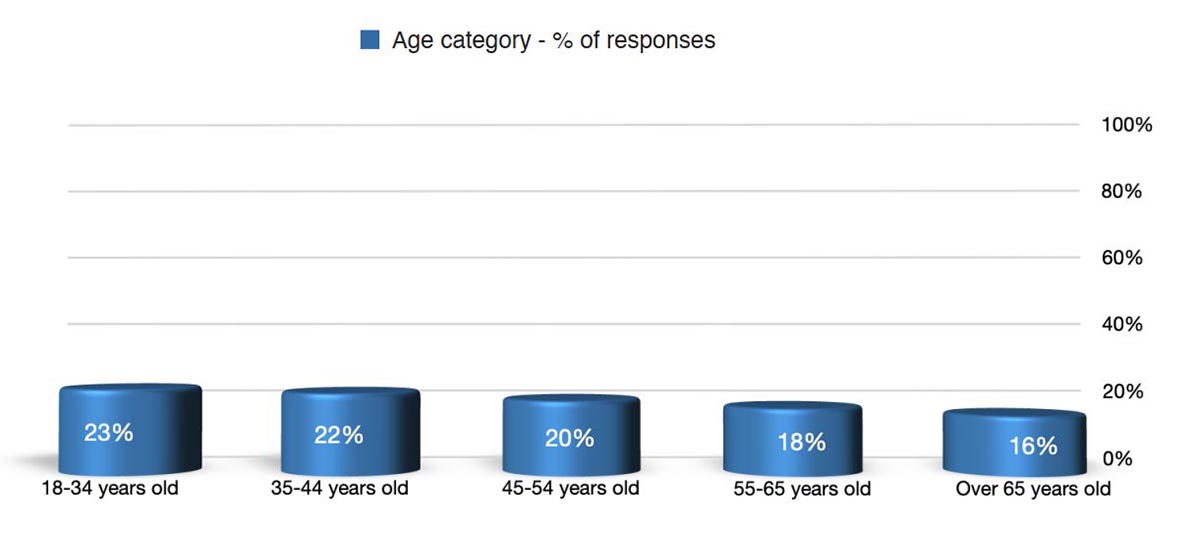
Age category - % of responses — Text version
| 18-34 years old | 35-44 years old | 45-54 years old | 55-64 years old | Over 65 years old |
|---|---|---|---|---|
| 23% | 22% | 20% | 18% | 16% |
Residence
The majority of respondents were residents of PEI (62%) including non-Indigenous (56%) and Indigenous (6%) communities.

Residence - % of responses — Text version
| Prince Edward Island | Indigenous community on PEI | Other Atlantic Canada | Other Canada |
|---|---|---|---|
| 56% | 6% | 13% | 25% |
Which category describes you and/or a group(s) you are affiliated with?
The general public (‘Local non-First Nations resident’ + ‘Non-local member of the general public’) was selected most frequently (80%) as the respondents’ affiliation or representation Footnote 3. The following chart shows respondents self-reported affiliation in ascending order Footnote 4.
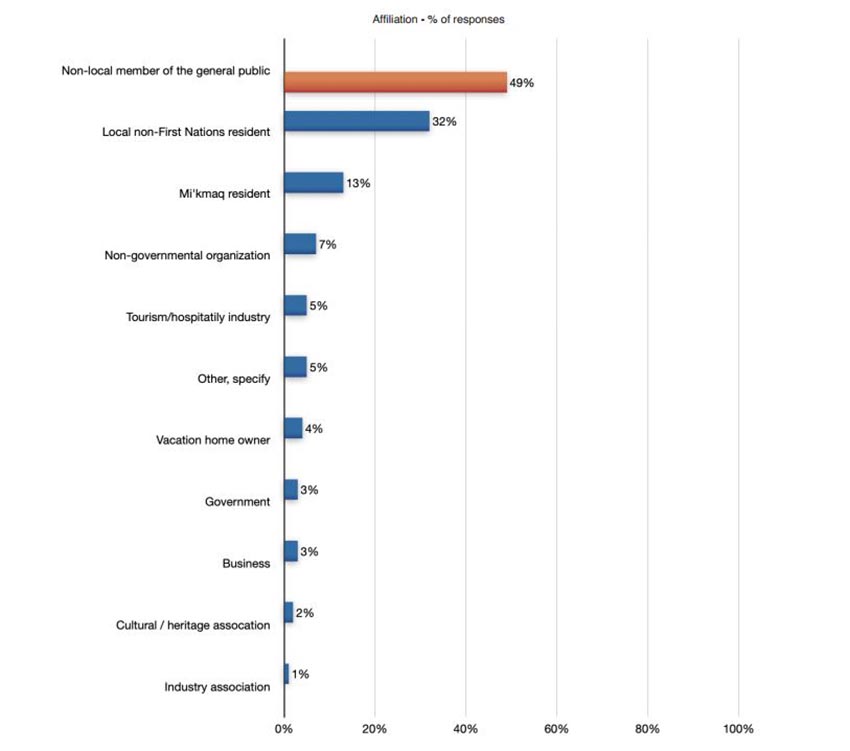
Affiliation - % of responses — Text version
| Non-local member of the general public | 49% |
| Local non-First Nations resident | 32% |
| Mi’kmaq resident | 13% |
| Non-governmental organization | 7% |
| Tourism/hospital industry | 5% |
| Other, specify | 5% |
| Vacation home owner | 4% |
| Government | 3% |
| Business | 3% |
| Cultural / heritage association | 2% |
| Industry association | 1% |
How did you hear about the proposal for a national park reserve in the Pituamkek area? Footnote 5
‘Social media’ (55%) was the most frequently reported by respondents in response to the question “How did you hear about the proposal for a national park reserve in the Pituamkek area”.
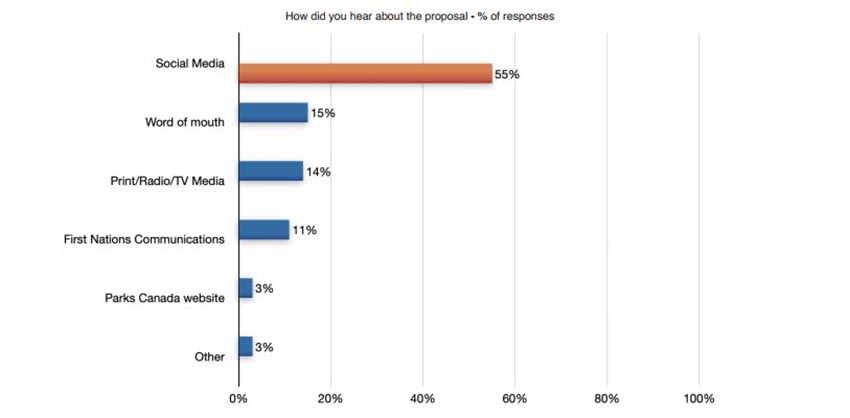
How did you hear about the proposal - % of responses — Text version
| Social media | 49% |
| Word of mouth | 32% |
| Print/Radio/TV media | 13% |
| First Nations communications | 7% |
| Parks Canada website | 5% |
| Other | 5% |
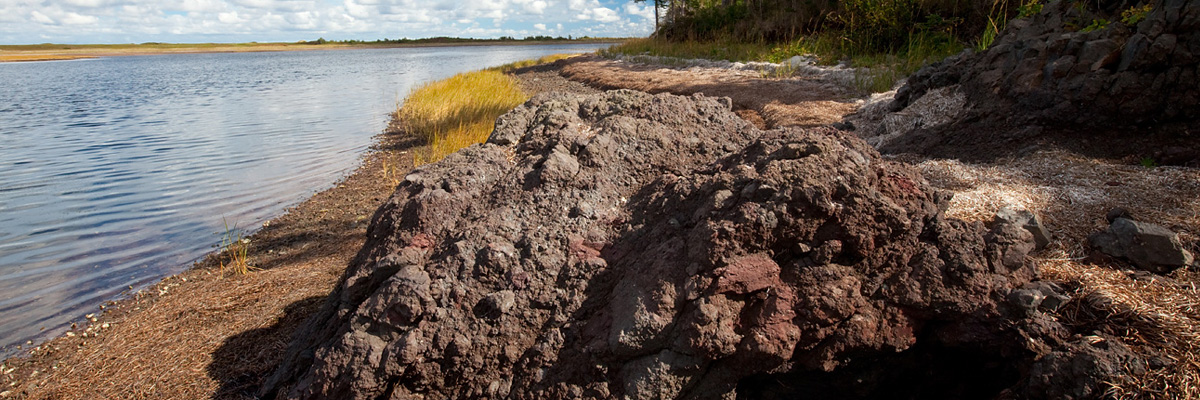
Survey responses - Themes summary
A series of open-ended questions invited respondents to express opinions and concerns about the creation of a national park reserve. Of the 214 survey responses, not every respondent answered every question. The key themes that emerged from the responses were the importance of preservation and conservation of the landscape, wildlife, and plants, as well as the continuing respect for Mi’kmaq rights and culture. Increased tourism and business opportunities were lower on the list of importances. Key concerns were the long-term impact on the environment due to increased use.
The following is a summary of the responses including summary text, charts, and a selection of relevant quotations.
3A. What benefits do you believe could come from the creation of a national park reserve in the northwestern area of Prince Edward Island? (n=194)
Respondents were given the opportunity to respond to “What benefits do you believe could come from the creation of a national park reserve in the northwestern area of Prince Edward Island?” in their own words.
There were 194 comments, most of which crossed multiple areas. The strongest common theme that received the most frequent mentions in respondents’ own words was the benefit of ‘Environmental, conservation, and protection (wildlife, landscape, etc.)’ with 168 comments (87% of responses) highlighted orange in the following chart.
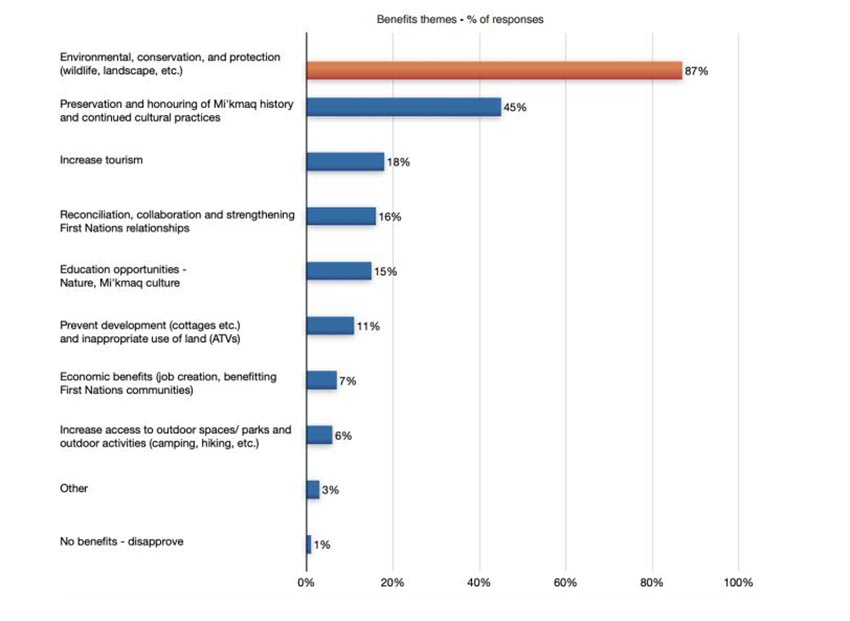
Benefits themes - % of responses — Text version
| Environmental, conservation, and protection (wildlife, landscape, etc.) | 87% |
| Preservation and honouring of Mi’kmaq history and continued cultural practices | 45% |
| Increase tourism | 18% |
| Reconciliation, collaboration and strengthening First Nations relationships | 16% |
| Education opportunities – Nature, Mi’kmaq culture | 15% |
| Prevent development (cottages etc.) and inappropriate use of land (ATV) | 11% |
| Economic benefits (job creation, benefitting First Nations communities | 7% |
| Increase access to outdoor spaces/parks and outdoor activities (camping, hiking, etc.) | 6% |
| Other | 3% |
| No benefits – disapprove | 1% |
Selection of quotations
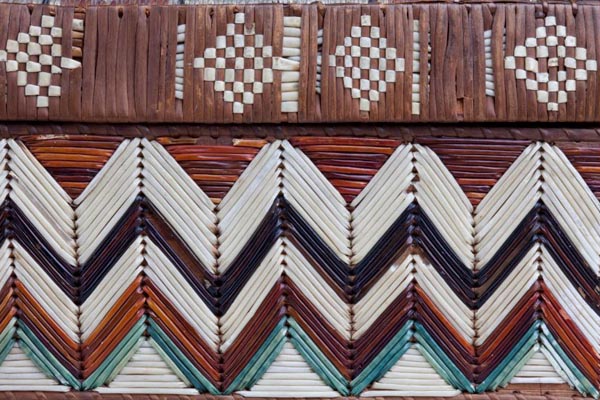
A. Environmental, conservation, and protection (wildlife, landscape, etc.) — (168 comments)
“Protection for that eco type...”
“Conservation of natural resources...”
“Preservation of wildlife, nature....”
“Environmental ... preservation. Safe haven for rare plants and animals...”
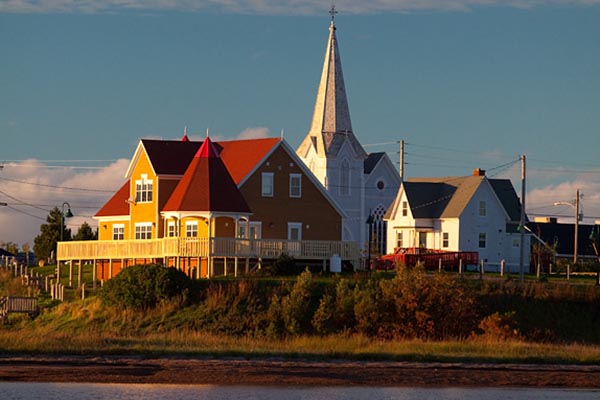
B. Preservation and honouring of Mi’kmaq history and continued cultural practices — (88 comments)
“Preserved traditional territory of the Mi’kmaq, preservation of burial sites”
“It can protect our lands to be used for ceremony uses such as fasting ceremonies for people who want to fast...”
“The benefits would include cultural heritage of Mi’kmaq people being preserved...”
C. Increase tourism — (34 comments)
“Lots of tourism could be involved in it.”
“Can draw tourists to the area...”
“...It’s a part of the Island that doesn’t get as much tourism...”
D. Reconciliation, collaboration and strengthening First Nations relationships — (30 comments)
“Restore their lands to them...”
“A true step in the action of reconciliation - a Nation to nation agreement to model for other land...”
“...It’s an opportunity to support Indigenous- Canadian relations”
E. Educational opportunities — Nature, Mi’kmaq culture — (29 comments)
“Educate the public and our youth on the history...”
“...awareness and promotion of human, cultural and natural history of the area...”
F. Prevent development (cottages etc.) and inappropriate use of land (ATVs) — (21 comments)
“... PEI is densely populated with limited protected parkland and judging from scans of recent real estate listing, there is what appears to be a higher than usual amount of shoreline being sold as small cottage lots”
“I hope that making the Sandhills a national park reserve would mean the area would be monitored to ensure destructive human activity like driving ATVs and building shacks would be eliminated...”
G. Economic benefits (job creation, benefitting First Nation communities) — (14 comments)
“...Employment opportunities for local Mi’kmaq”
“Creation of new reserve should benefit local Mi’kmaq community the most. If planned properly, management, interpretation and resource protection positions should be staffed by local Mi’kmaq...”
H. Increase access to outdoor spaces / parks and outdoor activities (camping, hiking, etc.) — (11 comments)
“More public outdoor spaces in a world where fewer and fewer people have yards...”
“...more access to parks and outdoor space”
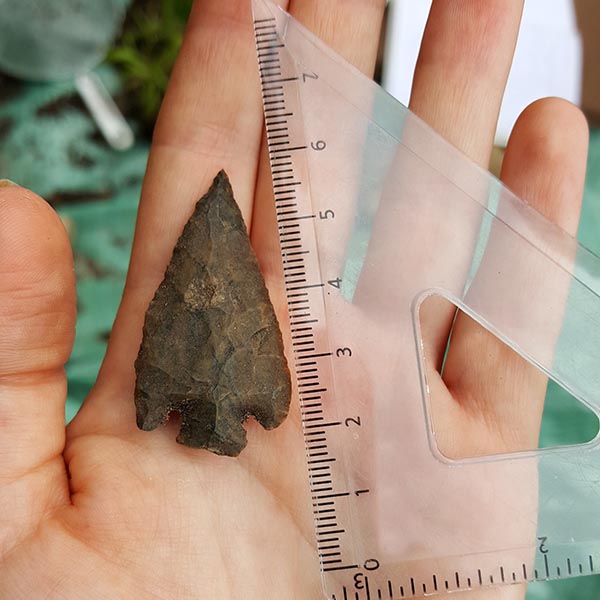
I. Other — (6 comments)
“Too many to count!!”
“...focus of research”
J. No benefits — disapprove — (2 comments)
“None. It stops groups of people, and only lets in others..”
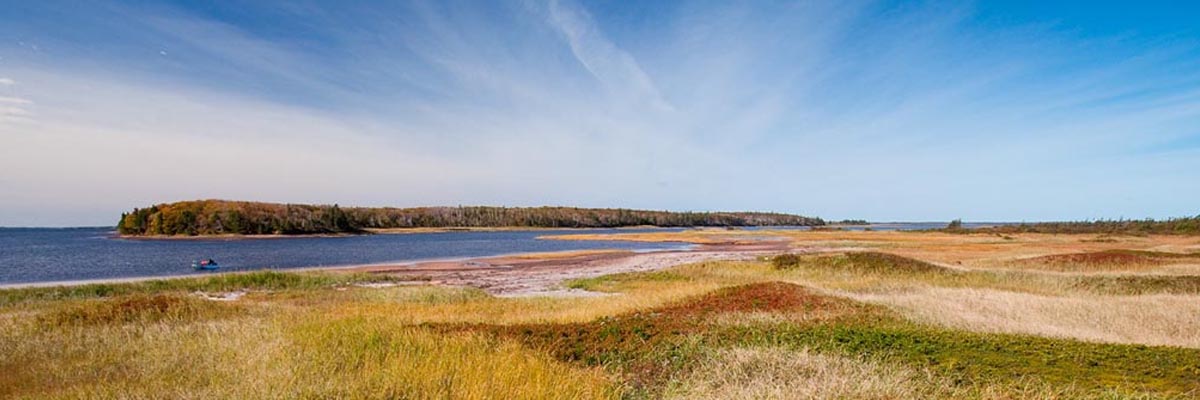
3B: Do you have any concerns about the creation of a national park reserve in the area? (n=195)
Respondents were given the opportunity to respond to “Do you have any concerns about the creation of a national park reserve in the area?” in their own words. Of the 195 respondents, 116 indicated they had no concerns about the project.
Of those who did indicate a concern (79 respondents), the most frequent theme was the potential impact on the environment due to development of facilities and increased human presence. The second most frequent theme was a concern about the proper consultation with and inclusion of the First Nations communities in the project.
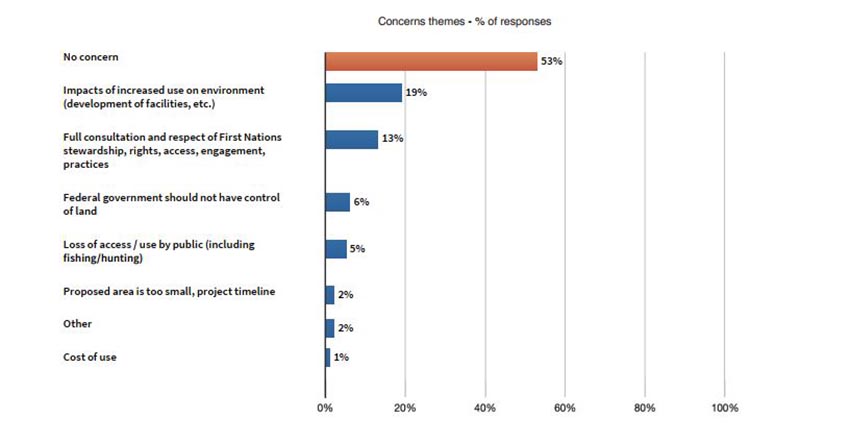
Concerns themes - % of responses — Text version
| No concern | 53% |
| Impacts of increased use on environment (development of facilities, etc.) | 19% |
| Full consultation and respect of First Nations stewardship, rights, access, engagement, practices | 13% |
| Federal government should not have control of land | 6% |
| Loss of access / use by public (including fishing/hunting) | 5% |
| Proposed area is too small, project timeline | 2% |
| Other | 2% |
| Cost of use | 1% |
Selection of quotations
A. Impacts of increased use on environment (development of facilities, etc.) — (41 comments)
“Human traffic is always bad”
“...I’m concerned more humans visiting destroying this sacred Island”
“My main concern is over development. The area needs to retain its wild character and beauty... All development should be contained to one place on “mainland” PEI, so people can visit it as it is in all its beauty.”
B. Full consultation and respect of First Nations — stewardship, rights, access, engagement, practices — (28 comments)
“My hope as a non-Indigenous person is that the voices and opinions of those who have historical rights to the land are heard.”
“Only that Canada will not truly honour the nation- to- nation spirit of this agreement in future should the land prove ‘valuable’ to the government.”
“None whatsoever — give the whole Island back to the Mi’kmaq.”
C. Federal government should not have control of land — (12 comments)
“My first choice would be to have the land returned to the Epekwitk Mi’kmaq people... If there is a concern it is that the Epekwitk Mi’kmaq people will not have ultimate control of the area.”
“Don’t care about a national park...give them back their lands...it’s theirs to begin with.”
D. Loss of access / use by public (including fishing/hunting) — (10 comments)
“Because it so beautiful would we be able to visit the Park?”
“No concerns as long as people can continue to visit the islands!”
E. Proposed area is too small, time to complete, project not successful — (5 comments)
“My only concern is could it be larger. We need more protected areas.”
“Only that it not happen...”
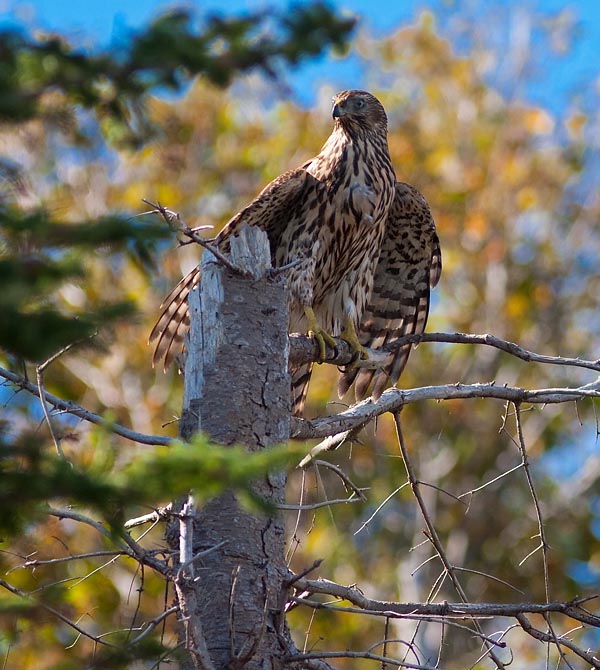
F. Other — (5 comments)
“Yes, about how erosion is affecting the sand bar.”
“Need to provide easy access and services like washrooms on the dunes / islands”
“Don’t care about a national park...give them back their lands...it’s theirs to begin with.”
G. Cost (fees) to use — (2 comments)
“The only thing I see as an issue with national parks could be charging money to come in, forcing some people to not be able to enjoy the nature. Other than that, I think parks are great.”
3C: Are there other activities you do in the area? Please list them (n=50)
Respondents were given the opportunity to respond to “Are there other activities you do in the area?” in their own words. There were 50 comments, most of which crossed multiple areas. The activity that received the most frequent mentions in respondents’ own words was ‘Walking/hiking’ with 17 comments (34%) highlighted orange in the following chart.
There were 3 themes that emerged where respondents indicated they had no knowledge of the area or no activities they would use the area for, these are excluded from the analysis of this question:
- They have never been/don’t live in PEI/Hadn’t heard of it before – (27 comments)
- Would like to visit someday – (15 comments)
- None, not applicable or don’t know – (14 comments)
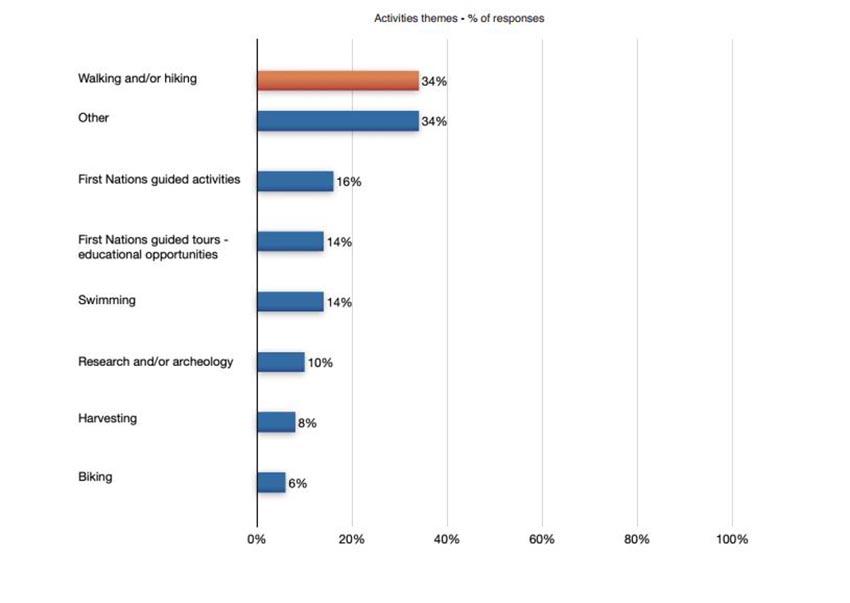
Activities themes - % of responses — Text version
| Walking and/or hiking | 34% |
| Other | 34% |
| First Nations guided activities | 16% |
| First Nations guided tours – educational opportunities | 14% |
| Swimming | 14% |
| Research and/or archeology | 10% |
| Harvesting | 8% |
| Biking | 6% |
What kinds of activities do you do in the area and how frequently?
‘Often’ and ‘Sometimes’ were both selected for the activity “Sightseeing” most frequently (14% and 37% respectively) and ‘Never’ was selected for “Fishing and/or hunting” most frequently (70%). The following chart shows the indicators by the frequency of participation in ascending order.
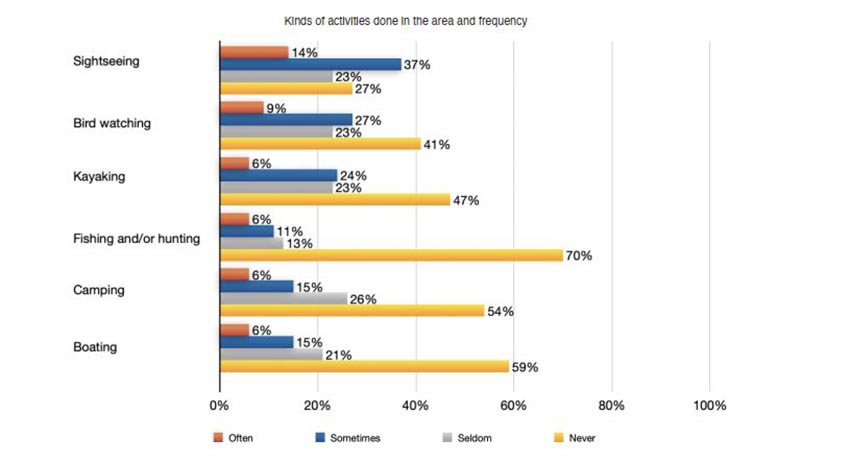
Kinds of activities done in the area and frequency — Text version
| Sightseeing (Often) | 14% |
| Sightseeing (Sometimes) | 37% |
| Sightseeing (Seldom) | 23% |
| Sightseeing (Never) | 27% |
| Birdwatching (Often) | 9% |
| Birdwatching (Sometimes) | 27% |
| Birdwatching (Seldom) | 23% |
| Birdwatching (Never) | 41% |
| Kayaking (Often) | 6% |
| Kayaking (Sometimes) | 24% |
| Kayaking (Seldom) | 23% |
| Kayaking (Never) | 47% |
| Fishing and/or hunting (Often) | 6% |
| Fishing and/or hunting (Sometimes) | 11% |
| Fishing and/or hunting (Seldom) | 13% |
| Fishing and/or hunting (Never) | 70% |
| Camping (Often) | 6% |
| Camping (Sometimes) | 15% |
| Camping (Seldom) | 26% |
| Camping (Never) | 54% |
| Boating (Often) | 6% |
| Boating (Sometimes) | 15% |
| Boating (Seldom) | 21% |
| Boating (Never) | 59% |
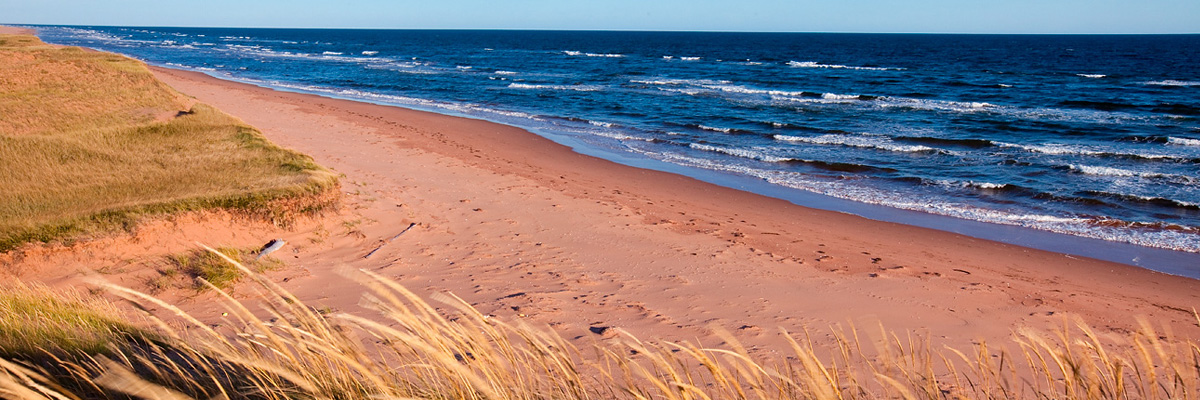
Selection of quotations
A. Walking and/or hiking — (17 comments)
“Walkabout”
“Hiking”
“Walk, hike and explore.”
B. Other — (17 comments)
“Shopping at tourist shops”
“Dining out.”
C. First Nations guided activities — (8 comments)
“All these activities should be under First Native control. It’s their land after all.”
“Access and opportunity limited right now. Visitor Center or Mi’kmaq experience Center, Indigenous dining”
D. First Nations guided tours — educational opportunities — (7 comments)
“Would like to view archaeological sites. Would like to accompany Indigenous tour guides to become familiar with the area.”
E. Swimming — (7 comments)
“Swimming!”
F. Research and/or Archeology — (5 comments)
“Genealogical and island history research”
G. Harvesting — (4 comments)
“Harvesting edible plants”
H. Biking — (3 comments)
“...biking, mountain biking...”
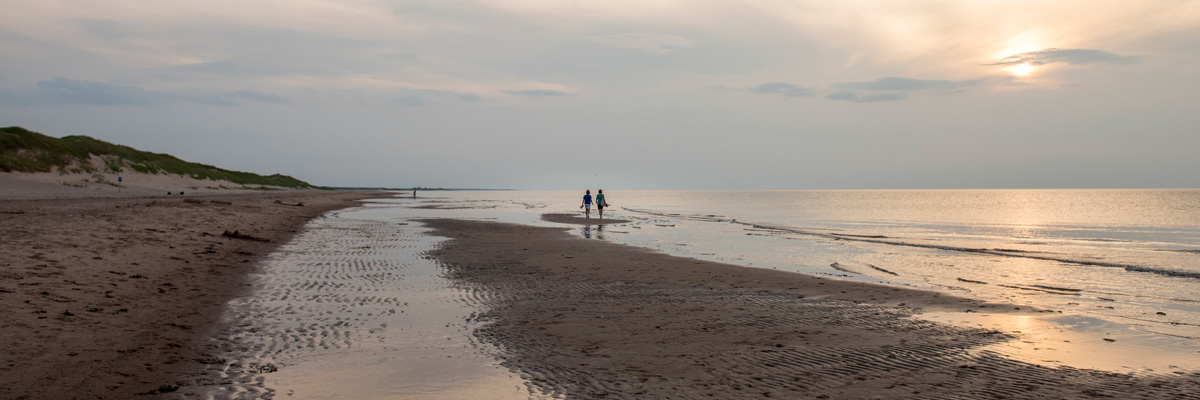
When do you tend to use or visit the Pituamkek area? (N=167)
‘Summer’ was selected most frequently (71%) as the time of year that the Pituamkek area was used or visited. The following chart shows the time of year when respondents indicated they tended to use or visit the Pituamkek area in ascending order. Footnote 6
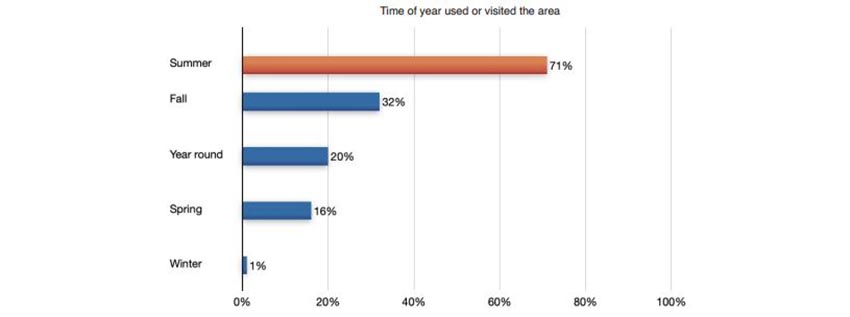
Time of year used or visited the area — Text version
| Summer | 71% |
| Fall | 32% |
| Year round | 20% |
| Spring | 16% |
| Winter | 1% |
3D: In your opinion, what level of importance should each of the following be given in establishing the new national park reserve?
Respondents were asked to rate the importance of a series of factors in the establishment of the new national park. ‘High importance’ was selected for the factor “Ecological values” most frequently (93%) and ‘High importance’ was selected for “Business opportunities” least frequently (8%). The following chart shows the indicators by the selection of the highest level of importance in ascending order.
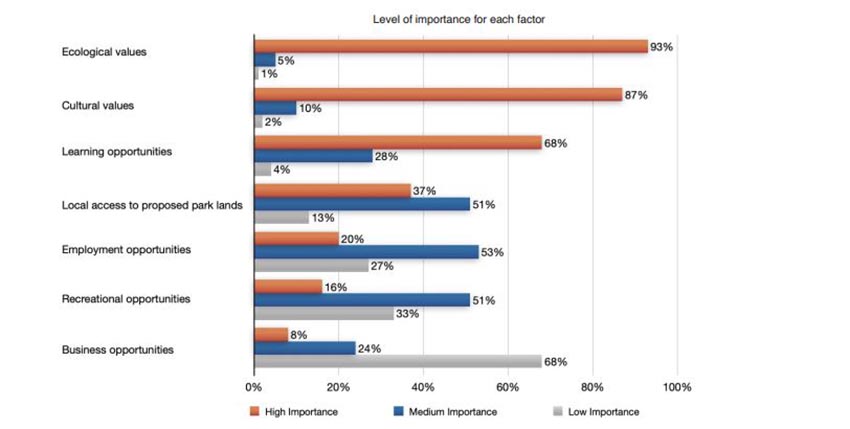
Level of importance for each factor — Text version
| Ecological values (High importance) | 93% |
| Ecological values (Medium importance) | 5% |
| Ecological values (Low importance) | 1% |
| Cultural values (High importance) | 87% |
| Cultural values (Medium importance) | 10% |
| Cultural values (Low importance) | 2% |
| Learning opportunities (High importance) | 68% |
| Learning opportunities (Medium importance) | 28% |
| Learning opportunities (Low importance) | 4% |
| Local access to proposed park lands (High importance) | 37% |
| Local access to proposed park lands (Medium importance) | 51% |
| Local access to proposed park lands (Low importance) | 13% |
| Employment opportunities (High importance) | 20% |
| Employment opportunities (Medium importance) | 53% |
| Employment opportunities (Low importance) | 27% |
| Recreational opportunities (High importance) | 16% |
| Recreational opportunities (Medium importance) | 51% |
| Recreational opportunities (Low importance) | 33% |
| Business opportunities (High importance) | 8% |
| Business opportunities (Medium importance) | 24% |
| Business opportunities (Low importance) | 68% |
Are there other factors that you feel are important to consider? If so, please describe. (n=85)
Respondents were given the opportunity to respond to “Are there other factors that you feel are important to consider?” in their own words. There were 85 comments, most of which crossed multiple areas. The strongest common theme that received the most frequent mentions in respondents’ own words was ‘Conservation - not developed, natural area is protected’ with 38 comments (45%) highlighted orange in the following chart.
There were 13 survey respondents who indicated they had no concerns; these are excluded from the analysis of this question.
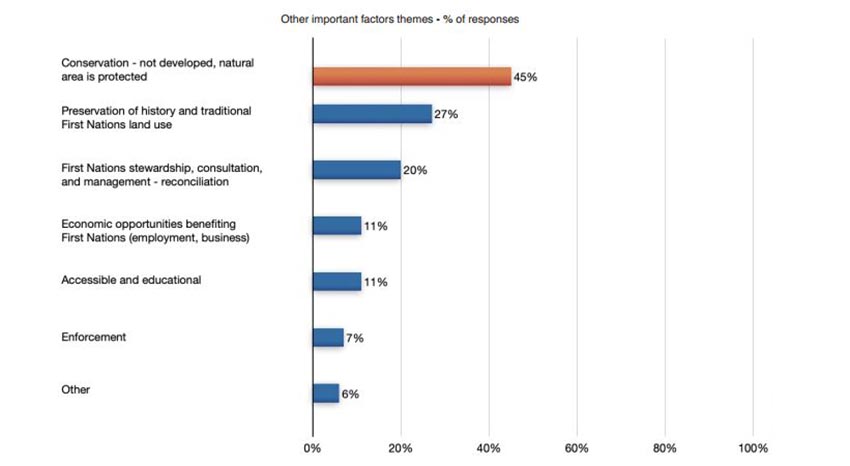
Other important factors themes - % of responses — Text version
| Conservation - not developed, natural area is protected | 45% |
| Preservation of history and traditional First Nations land use | 27% |
| First Nations stewardship, consultation, and management, reconciliation | 20% |
| Economic opportunities benefitting First Nations (employment, business) | 11% |
| Accessible and educational | 11% |
| Enforcement | 7% |
| Other | 6% |
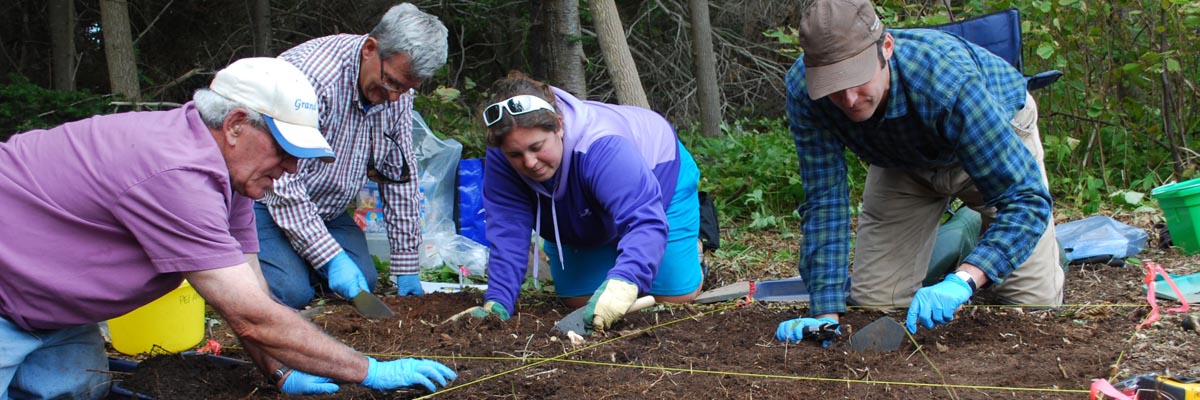
Selection of quotations
A. Conservation - not developed, natural area is protected — (38 comments)
“Damaging effects of invasive species. Damaging effects of man-made infrastructure and activities. Natural environment should be allowed to change naturally without human interference.”
“No roads, no bridges, limited by permit access for non- Indigenous people with Mi’kmaq approval only. Or no non- Indigenous access at all.”
“Long term impacts to the environment with increased activity.”
“If access is opened to the public and any recreational activity, ensuring the landscape and level of respect is maintained for the land being made accessible.”
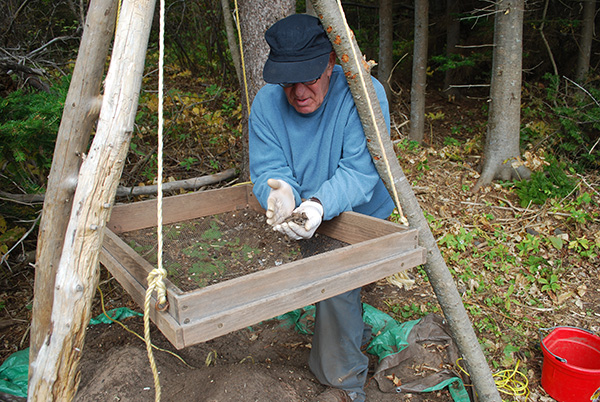
B. Preservation of history and traditional First Nations land use — (23 comments)
“Preservation and presentation of HISTORY”
“Preservation and traditional use should trump and business or recreational aspects of this area – over exploitation would not preserve what is necessary”
“I think the park shouldn’t prevent Mi’kmaq people from acting on their charter and treaty rights. I think business and employment opportunities should be directed to people that are Mi’kmaq....”
C. First Nations stewardship, consultation, and management — reconciliation — (17 comments)
“These lands need to be governed under principles of Indigenous stewardship.”
“It needs to be explicitly expressed that the Mi’kmaq are directing this. Please help others see that meaningful consultation and direction from Indigenous people on how to create, manage and utilize this Park Reserve.”
“These lands need to be governed under principles of Indigenous stewardship.”
D. Economic opportunities benefiting First Nations (employment, business) — (9 comments)
“Employment opportunities should be for Mi’kmaq people.”
“Business and financial opportunities should be directed to Indigenous people/organizations.”
E. Accessible and educational — (9 comments)
“Equitable access for all who want to visit.”
“Consult Mi’kmaq peoples... employ them to... teach others about the land”
F. Enforcement — (6 comments)
“With an increase in visitor numbers an increase in Ranger visibility is a must.”
G. Other — (5 comments)
“Just do it. Please.”
3E: What makes the Pituamkek area special to you? Why do you enjoy going there? (N=132)
Respondents were given the opportunity to respond to “What makes the Pituamkek area special to you? Why do you enjoy going there?” in their own words. There were 132 comments, most of which crossed multiple areas. The theme that received the most frequent mentions in respondents’ own words was ‘Nature, beauty, scenery’ with 82 comments (62%) highlighted orange in the following chart.
There were 3 themes that emerged where respondents indicated they had no knowledge of the area had no response; these are excluded from the analysis of this question: Footnote 7
- Have not been - (24 comments)
- Plan to/would like to go – (13 comments)
- None, not applicable or don’t know – (3 comments)
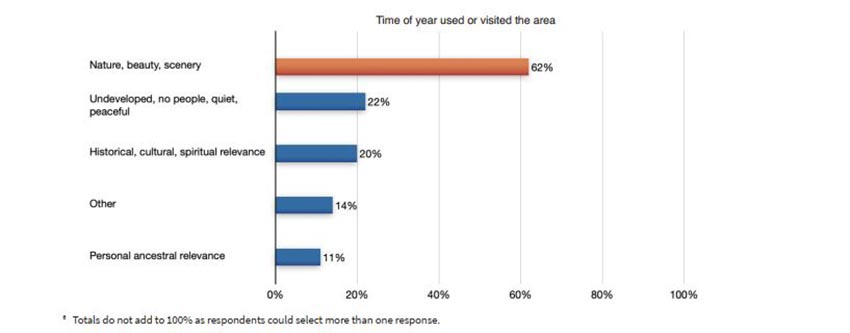
What makes the Pituamkek area special to you — Text version
| Nature, beauty, scenery | 62% |
| Undeveloped, no people, quiet, peaceful | 22% |
| Historical, cultural, spiritual relevance | 20% |
| Other | 14% |
| Personal ancestral relevance | 11% |
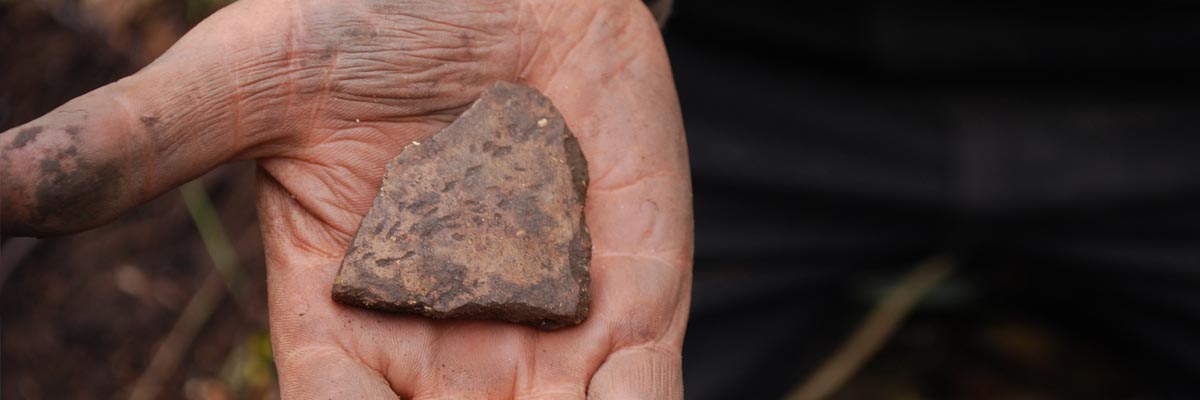
Selection of quotations
A. Nature, beauty, scenery — (82 comments)
“Nature. Pure and simple.”
“It’s natural untouched beauty.” “Scenery, nature, beautiful beaches.”
B. Undeveloped, no people, quiet, peaceful — (29 comments)
“What is special to me is this opportunity to save the area from development.”
“Still qualifies as ‘untouched by man’” “The natural beauty. The peacefulness.”
C. Historical, cultural, spiritual relevance — (26 comments)
“It has significant cultural importance to the Mi’kmaq - it is sacred ground. It is not a place where I tread lightly.”
“It’s history and importance to PEI First Nations.”
“...it is a sacred place.”
D. Personal ancestral relevance — (15 comments)
“Historical connection to the area and family connections.”
“It has great cultural and familial significance. My ancestors are from here.”
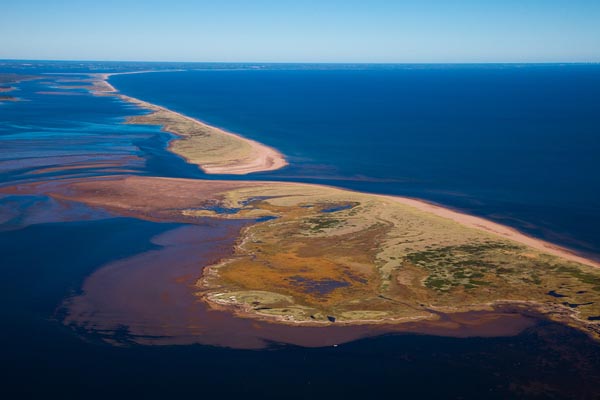
Photo: © Epekwitk Assembly of Councils
E. Other — (19 comments)
“Our earth is dying, and only by changing our occupation of these lands can we save it.”
“Great hunting and remoteness but yet close enough to be safe”
3F: Do you have additional suggestions, ideas, comments, or questions regarding the establishment of the proposed national park reserve in the Pituamkek area? (N=82)
Respondents were given the opportunity to respond to “Do you have additional suggestions, ideas, comments, or questions regarding the establishment of the proposed national park reserve in the Pituamkek area?” in their own words. There were 82 comments, most of which crossed multiple areas. The theme that received the most frequent mentions in respondents’ own words was ‘Reconciliation, return to First Nations control, ensure meaningful First Nations input’ with 26 comments (20%) highlighted orange in the following chart.
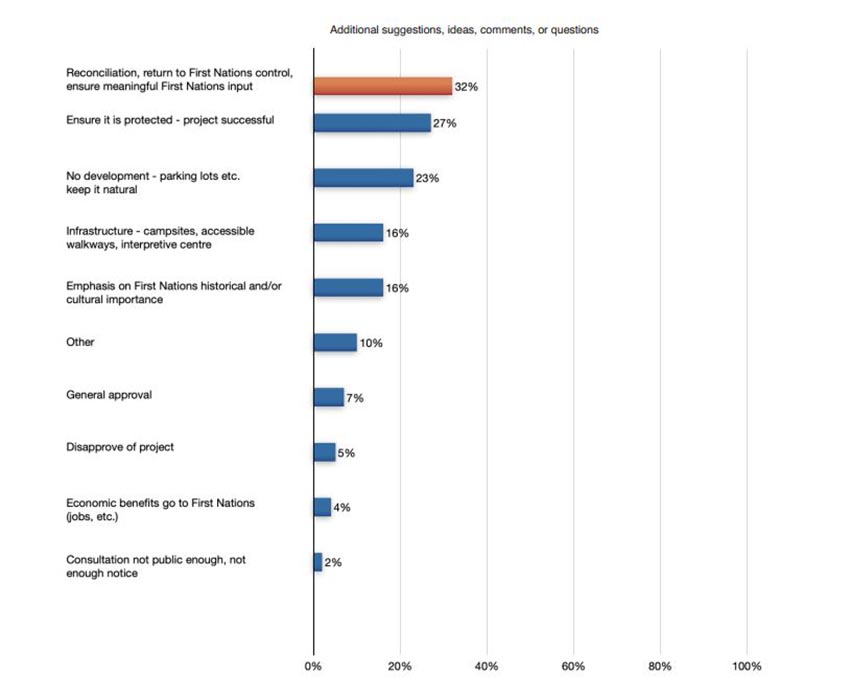
Additional suggestions, ideas, comments, or questions — Text version
| Reconciliation, return to First Nations control, ensure meaningful First Nations input | 32% |
| Ensure it is protected – project successful | 27% |
| No development – parking lots, etc. keep it natural | 23% |
| Infrastructure – campsites, accessible walkways, interpretive centre | 16% |
| Emphasis on First Nations historical and/or cultural importance | 16% |
| Other | 10% |
| General approval | 7% |
| Disapprove of project | 5% |
| Economic benefits for to First Nations (jobs, etc.) | 4% |
| Consultation not public enough, not enough notice | 2% |
Selection of quotations
A. Reconciliation, return to First Nations control, ensure meaningful First Nations input — (26 comments)
“Let the Mi’kmaq take the lead in how to preserve the land and honor their heritage.”
“Consult Mi’kmaq people.”
“Let First Nations decide what is to be done...it’s their land...stolen from them...but it’s still their land.”
B. Ensure it is protected — project successful — (22 comments)
“Just do it! Save it!”
“Please do not ruin it with beach access, roads and bridges. We already have lovely beaches to visit. Leave it for the First Nation and the wildlife.”
“Do it soon - do it right.”
C. No development — parking lots etc. — keep it natural — (19 comments)
“Keep it natural”
“There should be a national park reserve in the Pituamkek area and development, or businesses should not be allowed.”
D. Infrastructure — campsites, accessible walkways, interpretive centre — (13 comments)
“It would be good to have a cultural/interpretative centre and tours of the island provided by Indigenous people and local elders.”
“No roads, perhaps a boardwalk for walking or marked trails, and kayaking permitted. There should be an interpretive centre with learnings of the history in the area.”
E. Emphasis on First Nations historical and/or cultural importance — (13 comments)
“The oral and cultural history is rich and must be understood to fully appreciate its importance to the Mi’kmaq people.”
“Important to stress the significance of the land to the history of the Mi’kmaq.”
F. Other — (8 comments)
“There should not be fees for Islanders to visit/use the area.”
“Establish links with a university or college to develop a true storyboard”
G. General approval — (6 comments)
“I think that it is a brilliant concept and I heartily support it.”
“I think it’s a fantastic idea and hope that it moves forward successfully.”
H. Disapprove of project — (4 comments)
“No, it should not happen. No land it owned by any government”
“It belongs to the Mi’kmaq, the L’nuey. I don’t’ want a national park especially owning it. I don’t want non-natives visiting destroying it.”
I. Economic benefits go to First Nations (jobs, etc.) — (3 comments)
“What is planned for ensuring economic opportunities for Lennox Island?”
J. Consultation not public enough, not enough notice — (2 comments)
“I found your process taken on short notice, I missed the in-person meeting in my area, with no notice this was happening. Do not approve of your short notice on this consultation matter.”
Pituamkek public engagement sessions summary
There were 6 public engagement sessions held in June and July (2021) including 3 public consultations and 3 consultations with Mi’kmaq partners.
Four of the sessions were held virtually with a total of twelve participants. The two stakeholder consultations with Mi’kmaq partners were held in-person with a total of thirty participants.
The following is a summary of the broad themes that emerged during the consultation process.
Consultation sessions held
| Date | # in Attendance | Location |
|---|---|---|
| July 5, 2021 | 5 | Zoom - virtual meeting |
| July 14, 2021 | 3 | Zoom - virtual meeting - Bilingual |
| July 15, 2021 | 10 | Zoom - virtual meeting |
| July 19, 2021 | 15 | Abegweit First Nations, Scotchford, PE |
| July 19, 2021 | 15 | Lennox Island First Nations, Lennox Island, PE |
| July 19, 2021 | 1 | Zoom - virtual meeting |
Session agenda
The sessions were organized to include the following content:
- Greeting & Introduction
- Opening Prayer (by Julie Pellissier-Lush)
- Land acknowledgement
- Statement from Chief Darlene Bernard
- Pituamkek – A Mi’kmaq Heritage Landscape film/Mi’kmaq Heritage Landscape – the Journey to Today Proposed NPR – the Hope for the Future
- Presentation – including project background, the national park establishment process
- Your Voice: How to Contribute
- Introduction of the public survey
- Sharing of preliminary results of surveys (Sessions 3 through 6)
- Public input period
- Closing prayer (by Julie Pellissier-Lush)
Themes
The consultations comments and questions were analyzed for key themes.
There were 9 identified (themes having 3 or more comments/questions). The most mentioned theme was ‘conveyed concerns and the importance of the conservation of Pituamkek site’ with 7 comments.
The themes with the most comments (4 or more) are outlined the following table.
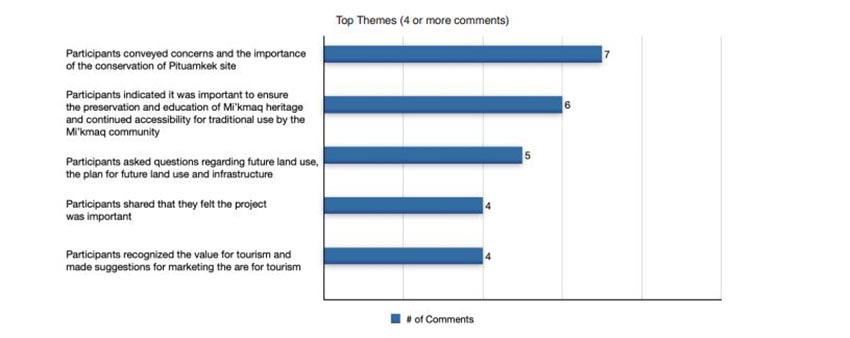
Top Themes (4 or more comments) — Text version
| Participants conveyed concerns and the importance of the conservation of Pituamkek site | 7 |
| Participants indicated it was important to ensure the preservation and education of Mi’kmaq heritage and continued accessibility fro traditional use by the Mi’kmaq community | 6 |
| Participants asked questions regarding future land use, the plan for future land use and infrastructure | 5 |
| Participants shared that they felt the project was important | 4 |
| Participants recognized the value for tourism and made suggestions for marketing the area for tourism | 4 |
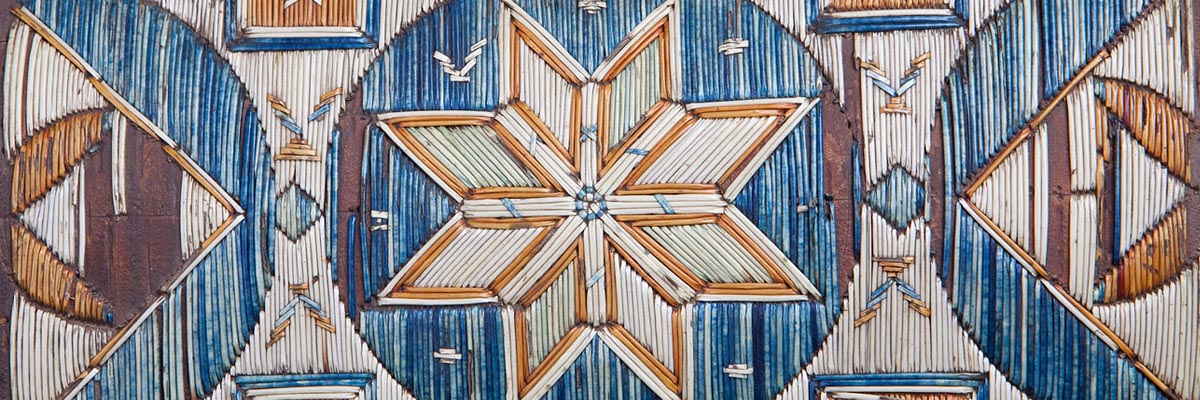
The following is a list of all themes in ascending order (number of comments) with a selection of relevant quotes.
1 Participants conveyed concerns and the importance of the conservation of Pituamkek site — (7 comments)
“I guess from our point of view the area is very important for migratory birds and waterfowl, so I think we’d like to see this area protected from that perspective. ...”
“...this is an important single area of PEI – nature...”
“What will an increase in human activity in this delicate landscape look like.”
“What does ‘protection’ mean? And should we be drawing people here?”
2 Participants indicated it was important to ensure the preservation and education of Mi’kmaq heritage and continued accessibility for traditional use by the Mi’kmaq community — (6 comments)
“...needs to be preserved for the Mi’kmaq people...”
“Would resource harvest (picking cranberries) and other traditional harvesting practices be allowed in the national park?”
“...kayaking, ceremony, learning about Mi’kmaq history, culture and all kinds of things - education!” – (French, translated)
3 Participants asked questions regarding future land use, the plan for future land use and infrastructure — (5 comments)
“At what point in the national park reserve process do we start to think about future use, or start having conversations around what use would look like?”
“A question was raised about Mi’kmaq land use and the potential for future infrastructure on the Islands.”
“Is there a plan for a cultural/interpretive centre?”
4 Participants shared that they felt the project was important — (4 comments)
“This is an important project”
“Excellent idea, something very important” – (French, translated)
5 Participants recognized the value for tourism and made suggestions for marketing the area for tourism — (4 comments)
“Agree, commercial importance - is not necessary to know the importance of the project” – (French, translated)
“Once took a tour of an island near Cape Breton. The tour went through different stations, each showcasing a different component of the cultural and ecological significance of the island – the full tour and participation took about an hour and really demonstrated the importance of the place and the preservation of the local Indigenous culture. This could be a potential example to follow in Pituamkek (perhaps for tourists to do before actually travelling to the island itself)”
6 Participants enquired about the land details — including ownership and coverage area — (3 comments)
“Who is the current landowner of all the land within the proposal? Is the government of Canada the owner? Private landowners?”
“What is the big percentage of terrestrial space you’re looking for?”
7 Participants asked questions regarding the consultation process and inclusiveness — (3 comments)
“I’m just wondering if you guys are doing any engagement sessions in person by chance? Anytime soon?”....Responds that as an engagement officer with L’nuey, he’s found engaging with Mi’kmaq elders easier and better through in-person engagement sessions / comments on the results of the survey”
“When doing the consultations, are there opportunities to talk to Islanders and non- Indigenous?”
8 Participants indicated they enjoyed the video/ video was good quality — (3 comments)
“*General consensus that quality of video was good*” – (recorded note)
“The video is very well done.”
9 Participants expressed they enjoyed the consultation meeting — (3 comments)
“Beautiful meeting.”
“Thank you, I learned a lot about the project, and I invite you to continue the good work”
10 Other minor themes — (Less than 3 comments). Participants:
a. Participants commented regarding the importance of community engagement and support.
b. Participants asked about how the survey being promoted and made available.
c. Participants commented on the archeological importance of the Pituamkek site.
d. Participants enquired about the next steps and timeline of the process.
e. Participants asked if the findings of the feasibility assessment and public
consultations would be made available to the public.
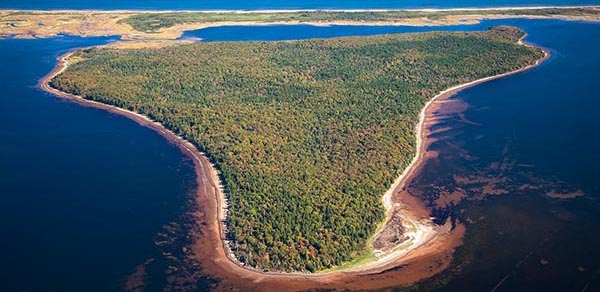
Conclusions
Overall, there was almost unanimous support for the Pituamkek project based on the findings of both the public engagement questionnaire and public engagement sessions.
The importance of conservation and future environmental protection was strongly represented throughout the public engagement activities. Respondents to the survey rated the factor ‘Ecological values’ the highest importance most frequently. In respondents’ own words, the strongest benefit of a national park in this area was “Environmental, conservation, and protection (wildlife, landscape, etc.).”
The majority of survey respondents indicated they had no concerns about the creation of a park reserve in the area. Of the 79 respondents who expressed concerns, 52% were concerned about the “Impact of increased use on the environment (development of facilities, etc.).”
Throughout the survey responses and public consultations, the importance for conserving and protecting the Pituamkek site was the strongest theme. Preservation of the wildlife, the landscape, the flora and fauna were all of primary importance. Ongoing protection and preservation of Mi’kmaq heritage, along with continued accessibility to the land, and traditional land use by the Mi’kmaq community was strongly supported. For the project to be successful, continued consultation, dialogue and preservation of Mi’kmaq heritage, rights, and culture was seen as essential.
The theme of conservation and preservation in respondents’ answers was strong across all subjects from the questionnaire and the engagement sessions. The Pituamkek site was repeatedly described as beautiful, serene, natural, quiet, and undeveloped. One of the most common concerns was that without the creation of a park or reserve, the land may suffer from human development and increased use.
Data analysis of the survey responses and public consultations demonstrates an overwhelming support for the creation of a new national park reserve in Pituamkek (Hog Island and the Sandhills). Environmental, cultural, and historical conservation, preservation, and protection, coupled with the importance of respect for the First Nations communities through consultation and continued access, were identified as the top themes. Although concern for the potential overdevelopment or degeneration of the land was identified in the data set, it was minimal compared to the supportive responses for the project.
Throughout the survey responses and public consultations, the importance for conserving and protecting the Pituamkek site was the strongest theme.
More information
Publication information
PDF prepared by:
Revolution Media
1119 Water Street, Charlottetown, PE
Phone: 902-367-5060
revolution.ca
Related links
- Feasibility assessment on the creation of a national park reserve in Pituamkek (Hog Island Sandhills)
- Public engagement survey and consultations summary — Proposed National Park Reserve in Pituamkek (Hog Island and the Sandhills)
- Memorandum of understanding for proposed National Park Reserve in Pituamkek (Hog Island and the Sandhills)
- Date modified :